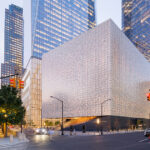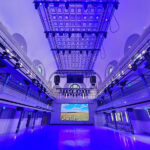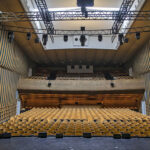It’s 5:00 p.m. on a gray, drizzly night on the north side of Chicago. Surrounded by the urban campus of Northeastern Illinois University, the production studios of Chicago’s PBS affiliate, WTTW 11 Network Chicago, are deceptively still on the outside. A few security guards and a packed parking lot are the quiet indicators of what waits for me inside.
As I pull in, one of the security guards seems to know exactly who I am, and quickly ushers me inside to meet up with her “pal.” Her pal, as it turns out, is Emmy-nominated Jim “Herbie” Gedwellas, resident lighting designer for the studio’s shows, including tonight’s taping of Soundstage. Gedwellas greets me with a beaming smile and a brightly colored Don Ho shirt.
5:15
Sound check is running a little bit long tonight, so we roam over to Studio D, home of music series Soundstage and Legends of Jazz. Both series are broadcast on PBS affiliates nationwide. As the New York Dolls work the kinks out of a couple of songs on stage, I have the chance to wander around in the 10,000 squarefoot studio.
The stage apron runs at an angle through the room, dividing the room nearly in half from one corner to another. A sturdy platform that was built by community carpenters, the riser lives in Studio D year-round, and removing it would be synonymous with destroying it.
The wall to the right side of the audience is embellished with arches and grate work of a non-determinate period, while the wall to the rear of the audience includes a faux balcony with a small amount of additional seating.
6:00
“The original Soundstage series started in, I believe, 1972.
“It went to about 1981. After 10 years, it went away and didn’t come back until about three years ago.”
This is how Gedwellas begins to narrate the history of Soundstage to me as we sit down to dinner with the crew. The show was resurrected in 2003, he tells me.
“Joe Thomas, from HD Ready, approached WTTW. He wanted to revive Soundstage, and he wanted the name Soundstage because it had history.”
Having been the lighting designer for the original run in the ‘70s, Gedwellas was tapped as the lighting director for the revival, working with lighting designers Bob Peterson and Mike Dalton.
“The producers had a concept that they wanted it all in black drape, almost like in limbo, just with silver trusses. That was pretty much it. They wanted that intimate, nightclub atmosphere.
“At that time I was the lighting director and a guy named Mike Dalton did exactly what Joe said, and it just didn’t work out really well. Once Joe found out that all of his camera angles were pretty much just black background behind all the singers, he goes ‘Oh, maybe we need some scenery.’ ”
Eventually, Gedwellas took over the designer’s chair, working closely with the producer to embellish the backgrounds and designing custom drapery that would react well to different lighting looks.
7:05
The entire lighting crew seemed to favor the brownies as tonight’s dessert of choice. There are two techs and two programmers here from Upstaging tonight. The regular crew will be out for the next taping, so the fill-in crew is getting a grip on how the show works.
Upstaging claims Gedwellas as one of their earliest customers. Georg Slejko, an account manager with Upstaging, began handling accounts for Gedwellas in the early nineties and claims that Gedwellas might even be customer #003 on Upstaging’s books.
Be prepared to hear high praise if you mention Herbie to Slejko. He says, “Herbie is well rooted in live performance lighting, always pushing the envelope of the studio lighting discipline to a successful conclusion.”
The relationship goes beyond the studio, with one of the most recent Soundstage remotes finding Gedwellas and his team at the Red Rocks Amphitheater in Colorado for four nights with Dave Matthews. Upstaging gear and crew could be found littering the outdoor amphitheater and lighting up the indigenous red rock walls.
7:25
As we make our way back in to the studio, things are pretty quiet. As I snap off a few pictures, Upstaging programmer Dave Ambrosio sits at the console tweaking some of the cues he has built for tonight’s show.
Gedwellas brought Ambrosio on after becoming the lighting designer for the series. “Dave and I had worked together before. I liked the way he ran the automated lights. So we added a lot more automated lights once Dave came in, so we could do different layers and things like that.”
Although the studio has a semi-permanent set and seating area, the room is still outfitted as a traditional studio, with wall-to-wall motorized lighting battens and no proscenium to speak of.
Several banks of ACLs light the grid in a cautionary hue of orange, drawing your eyes to the massive array of fixtures used to light the performers, the set, drapes, audience and anything else that might be in a camera shot.
The conventional rig resides, for the most part, on the installed battens. De Sisti 2K Fresnels, ETC Source Four PARs, and ETC Source Four ellipsoidals provide the bulk of the white light in the room, with a handful of De Sisti 5Ks and some PAR 46s thrown in for good measure.
8:00
As the ushers methodically seat the audience, I get a few minutes to talk with Ambrosio and Gedwellas about the automated rig. Perched behind a Flying Pig Systems Wholehog 2 console, Ambrosio has donned a shirt to rival Gedwellas. Watched over by an 18-inch tall singing James Brown doll, he has access to a wide variety of fixtures from Martin, VariLite, Robe and High End Systems.
Aside from the smorgasbord of moving lights, Ambrosio also feeds content to the vari- ous LED fixtures on stage via a Martin Maxedia media server. Some of the most eye-catching components of the set, Element Labs VersaTile and VersaTube systems have been layered to create columns, borders, and walls of color.
Gedwellas says, “When we started in to this year, Joe went over to Upstaging’s new place in Sycamore. Joe just wanted to nose around and see what was new. He saw the VersaTubes, and he liked the look. And, he liked the VersaTile look.
“Joe looks at music videos or American Idol, sees a platform he likes or an effect he likes. He doesn’t know exactly how they did it, but that’s how he approaches the design.”
8:45
With the audience seated and a little bit restless, the FOH riser quakes beneath us as Thomas does last minute video checks on the intercom.
Nearly a dozen plasma displays hang from the set, and Upstaging’s Matt McGregor has provided the video truck with some extra content to use for tonight’s show. As Thomas latches his intercom, I hear things like this:
“Okay, show me the first clip from Matt. The green one. Okay, we’ll call that one ‘Matt 1’.”
“I like that purple one. Call it ‘Matt 3’. Save it for the last song.”
As this goes on, the other six people at FOH are quick to give McGregor a hard time. It becomes apparent that the regular Soundstage crew and their other Upstaging brethren are a tight group, and that some good-natured ribbing is the norm.
8:55
With five minutes to the start of the show, the conventional rig is brought up to show level and the truss structure above the stage lights up.
Designed to be more versatile than in years past, the truss system can be re-shaped from one show to the next, offering the designers a modified look for each recording. Pieces of the structure are placed very consciously to retain use of the motorized battens above them.
A close connection between programmer and designer is easy to spot as Ambrosio pours a cup of wine for Gedwellas…an apparently enjoyable California red that has been airing out by the console for a while.
9:05
Once the show has started, there is not a lot of vocal interaction between designer and programmer. Gedwellas spends most of his time watching the monitor in front of him, switching between views from nine different HD cameras in the room, calling out slight adjustments to his conventional board operator and follow spots.
Ambrosio works his way through his previously programmed verse and chorus looks, deftly tapping between cues on beat while making adjustments to the LEDs that are being requested on the fly by the director.
9:45
During a tape reload, I asked Gedwellas about how he works with different programmers. He described his hands-off approach.
“I’ve always been a believer…if you have a really strong automated lighting programmer or designer…if you leave them alone and give them the freedom to create, you’re going to get a lot more out of that person then if you sit there and call out every instrument number…
“What I find really interesting is that automated programmers slash designers…everybody has a different eye and a different feel. We did country-western the other day and Tyler Elich ran the board for me. So, you can have the same amount of instruments, and when I looked at some of Tyler’s work, I went, ‘It’s Dave, but it isn’t Dave.’ It’s got his own personal taste to it. And his was perfect because it was kind of a softer look and we had two women countrywestern singers.”
10:30
As the cameras reload for the second and fi- nal time of the night, Gedwellas gives me some insight into his approach for running this show.
“I’m kind of the liaison, so that people don’t come up to Dave constantly. I keep my eye on light levels, and I just take notes. Then I work with Joe and the video shader, and maybe the band’s LD. I make sure that everything is colorcorrected. I call the follow-spots during the show. I watch the monitor and punch through the nine cameras during the show to see if any backgrounds or scenery are running too hot, or don’t have enough light, or maybe we can put a pattern in a certain shot and move it down. We do that all on the fly during the show.”
11:15
Walking out of the studio and back into the rain, I am struck once again by the unassuming façade outside Studio D. The damp night is a sobering contrast to the colorful lights and people only fifty feet away. For a little more than a month each spring and fall, Gedwellas and his team flawlessly transform this modest TV studio into a concert Soundstage.
Phil Gilbert is a freelance lighting designer / programmer. He can be reached at pgilbert@plsn.com.


